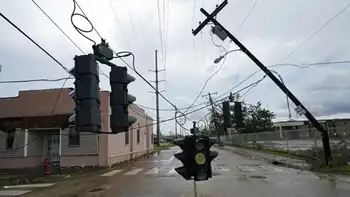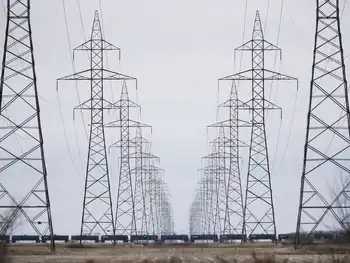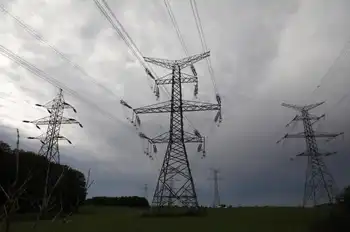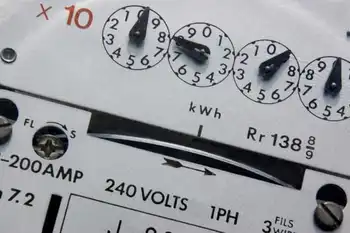Experimenting with floating wind turbines
Even its location isn't unique - though most wind turbines today are on land, there are a few offshore projects.
But unlike other offshore wind turbines that are anchored to the sea floor, this one floats.
Built by Siemens AG for Statoil ASA, an energy company based in Stavanger, Norway, the Hywind turbine sits on a buoyant steel cylinder extending 100 meters below the surface. Three heavy cables anchor it to the ocean floor.
Statoil wants to use this first Hywind turbine to show that wind turbines floating in deep water are a viable way of generating wind power while avoiding some of the regulatory and public-perception problems that come with wind farms on land.
It's not the only company experimenting with floating platforms. An eight-megawatt floating unit has been tested off Italy, and there are plans for a deep-water wind farm off Portugal using a floating platform design called WindFloat from Principle Power Inc. of Seattle.
Hywind, however, is the only full-scale floating wind turbine feeding electricity into a commercial power grid today, says Sjur Bratland, asset manager for Hywind at Statoil. The unit sent its first power across an undersea cable on Sept. 21, 2009, and as of late February, it had produced a million kilowatt-hours altogether.
That's well below the wind turbine's theoretical capacity, because it has not been running full time. Statoil has been stopped and started it repeatedly to make adjustments, says Bratland. "Our goal is not to produce power but to test it [the floating windmill concept]."
Since late December, Hywind has been running more like an ordinary wind turbine, with few stops and starts. In one 24-hour test period, Bratland says, it proved that it can outperform the generating capacity of comparable onshore turbines.
That wasn't a complete surprise, because one reason for building wind turbines that float is that winds are generally stronger and more consistent at sea than on land.
Another reason to build floating platforms for wind turbines is what some call the NIMBY problem. Not In My Back Yard, that is. Even people who favour green energy sources often don't want windmills near their homes. They cite noise, unsightliness, and the disruption that comes with the construction of a large wind project as reasons for wanting windmills placed away from their homes and communities.
"The NIMBY effect is one of the challenges that is easily taken care of with offshore [wind platforms]," says Bratland.
Going offshore doesn't answer all objections, though.
There are still fears of migratory birds being killed by flying into blades. Anne Murray, conservation committee co-chair at the Federation of British Columbia Naturalists, says many birds fly well out to sea, and the effects of wind turbines on them even far from land are still uncertain.
It also remains to be seen what aquatic life will make of the platforms if they start to be built in great numbers.
Alla Weinstein, chief executive of Principle Power, says fish may treat the platforms like artificial reefs. That could be a safety concern if it attracts commercial fishing close to the turbines, but the floating windmills don't appear to pose a risk to the fish themselves, she says. And she adds that the cables used to anchor the platforms will be "chains a couple of feet wide" that marine life like whales and dolphins can detect easily and won't swim into.
Still, Murray says, people have to keep in mind that no offshore technology completely eliminates environmental issues.
There are already offshore turbine installations where windmills are anchored permanently to the sea floor, and there are patches of shallow water far out at sea where this type of installation is feasible, Bratland says. So why are companies like Statoil so keen on developing floating platforms?
"The main advantage as we see it is that you can do most of your commissioning and assembly on shore or in shallow water and tow it out to sea," he says.
And floating platforms can be placed almost anywhere, including deep water, allowing much more flexibility for developers. The Hywind design will work in 120- to 700-metre depths, while Weinstein says WindFloat platforms can go anywhere the water is 35 metres deep or more. That makes it easier to lay out a wind farm for optimal production without being constrained by the terrain of the sea bottom, Bratland says.
Another good thing about floating platforms is that the underlying technology really isn't new.
The wind turbine on the top of the platform is still just a wind turbine, and the "floater" is very much like an offshore oil rig, says Jennifer Zajac, senior editor at SNL Energy, a research firm in Charlottesville, Virginia. "They're not exactly reinventing the wheel here."
Weinstein says this matters a lot when getting projects approved. She knows, having previously worked for a company involved with offshore wave turbines, that regulators don't understand them well and processes aren't well established for approving installations that are permanently mounted on the sea floor. Since wind turbine platforms like WindFloat are so similar to existing drilling platforms, "processes and standards exist," she says.
So what's the commercial potential for offshore wind power?
A Harvard University study last year suggested wind could produce 40 times as much electricity as the world now uses, and offshore wind would account for about a sixth of that, the study said. But in the U.S. today the proportions are the other way around, with less than a fortieth of power coming from wind, according to the report - although wind accounted for 42 per cent of new generating capacity in 2008, so the balance is starting to shift.
North America is relatively new to the renewable energy game, and is playing catch-up to Europe.
"Europeans are putting money where their mouth is" on alternative energy, Weinstein says.
Statoil expects to test its first Hywind unit for two years before moving towards a larger project. The company is also talking with researchers at the University of Maine and in Scotland about further feasibility studies, but it needs to secure more financing to move the project along, he says.
One of the things holding the industry back is the fact that generating electricity from the wind is still a relatively new industry, and the lion's share of existing development has been land-based. The costs involved with taking wind farms offshore remain uncertain.
"Offshore wind power is still a very immature business," Bratland says.
While Weinstein says the overall cost of floating turbines should be comparable to those on land, Bratland says offshore turbines in general - whether fixed or floating - can cost up to 50 per cent more to build at the moment.
Those up-front capital costs would drive up electricity rates, Zajac says, and that is holding the idea back.
However, she says, the recession may actually help the industry gain momentum by offering the potential to create new jobs, and as the demand for clean energy and Americans' desire to reduce dependence on foreign sources of energy grows.
"If it [offshore wind technology] works the way Principle and other manufacturers are talking about," Zajac says, "then yes, this could potentially be very big."
Related News

Louisiana power grid needs 'complete rebuild' after Hurricane Laura, restoration to take weeks
LAKE CHARLES - The main power utility for southwest Louisiana will need to "rebuild" the region's grid after Hurricane Laura blasted the region with 150 mph winds last week, top officials said.
The Category 4 hurricane made landfall last Thursday just south of Lake Charles near Cameron, damaging or destroying thousands of electric poles as well as leaving "catastrophic damages" to the transmission system for southwest Louisiana.
“This is not a restoration," Entergy Louisiana president and CEO Phillip May said in a statement. "It’s almost a complete rebuild of our transmission and distribution system that serves Calcasieu and Cameron parishes.”
According to Entergy,…





